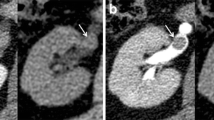Abstract
Purpose
To determine the feasibility of performing dual-energy CT with a single-source spectral detector system in obese patients.
Materials and methods
Retrospective, IRB-approved review of 28 patients weighing ≥ 270 lbs (122 kg) who underwent CT of the abdomen on a single-source spectral detector system was performed. Two blinded, independent radiologists rated relative preference between conventional CT images taken at 120 kVp (CCT120) and monoenergetic 70 keV equivalent (MonoE70) as well as iodine map image quality in the spleen, pancreas, kidneys, and liver. Signal-to-noise ratio (SNR) and contrast-to-noise ratio (CNR) were compared between conventional CT and MonoE70 images and correlated with body habitus markers of weight, height, and abdominal diameter.
Results
MonoE70 images were preferred by radiologists 100% of the time (1-sample t test, p < 0.0001) over conventional CCT120 images. Noise was significantly lower; SNR and CNR were significantly higher in MonoE70 images than in CCT120 images (paired t tests, p < 0.0001). Mean iodine map rating (scale 1–5) was 4.54 ± 0.58, denoting near homogenous and complete iodine mapping through the spleen, pancreas, kidneys, and liver for the majority of patients. Body habitus markers were not significantly correlated with image preference score; noise; MonoE70 SNR; MonoE70 CNR; change in noise, SNR, or CNR from CCT120 to MonoE70, or iodine map quality; ordinal and linear regression, p = 0.2547, p = 0.6837, p = 0.1888, p = 0.5489, p = 0.9830, p = 0.8849, p = 0.8741, p = 0.1522, respectively.
Conclusion
The single-source spectral detector implementation of dual-energy CT provides viable, high-quality imaging for obese patients.




Similar content being viewed by others
Abbreviations
- CCT120:
-
Conventional CT images taken at 120 kVp
- CNR:
-
Contrast-to-noise ratio
- DECT:
-
Dual-energy CT
- MonoE70:
-
Virtual monoenergetic 70 keV equivalent dual-energy images
- SNR:
-
Signal-to-noise ratio
References
Modica MJ, Kanal KM, Gunn ML (2011) The obese emergency patient: imaging challenges and solutions. RadioGraphics 31:811–823. https://doi.org/10.1148/rg.313105138
Parry RA, Glaze SA, Archer BR (1999) The AAPM/RSNA physics tutorial for residents. RadioGraphics 19:1289–1302. https://doi.org/10.1148/radiographics.19.5.g99se211289
Huda W, Scalzetti EM, Levin G (2000) Technique factors and image quality as functions of patient weight at abdominal CT. Radiology 217:430–435. https://doi.org/10.1148/radiology.217.2.r00nv35430
Johnson TR (2012) Dual-energy CT: general principles. Am J Roentgenol 199(5_supplement):S3–S8
Megibow AJ, Sahani D (2012) Best practice: implementation and use of abdominal dual-energy CT in routine patient care. Am J Roentgenol 199:S71–S77. https://doi.org/10.2214/AJR.12.9074
Rajiah P, Abbara S, Halliburton SS (2017) Spectral detector CT for cardiovascular applications. Diagn Interv Radiol 23:187–193. https://doi.org/10.5152/dir.2016.16255
Rassouli N, Chalian H, Rajiah P, Dhanantwari A, Landeras L (2017) Assessment of 70-keV virtual monoenergetic spectral images in abdominal CT imaging: a comparison study to conventional polychromatic 120-kVp images. Abdom Radiol 42:2579–2586. https://doi.org/10.1007/s00261-017-1151-2
Apfaltrer P, Sudarski S, Schneider D, et al. (2014) Value of monoenergetic low-kV dual energy CT datasets for improved image quality of CT pulmonary angiography. Eur J Radiol 83:322–328. https://doi.org/10.1016/j.ejrad.2013.11.005
Leng S, Yu L, Fletcher JG, McCollough CH (2015) Maximizing iodine contrast-to-noise ratios in abdominal CT imaging through use of energy domain noise reduction and virtual monoenergetic dual-energy CT. Radiology 276:562–570. https://doi.org/10.1148/radiol.2015140857
Pinho DF, Kulkarni NM, Krishnaraj A, Kalva SP, Sahani DV (2013) Initial experience with single-source dual-energy CT abdominal angiography and comparison with single-energy CT angiography: image quality, enhancement, diagnosis and radiation dose. Eur Radiol 23:351–359. https://doi.org/10.1007/s00330-012-2624-x
Sauter AP, Kopp FK, Münzel D, et al. (2018) Accuracy of iodine quantification in dual-layer spectral CT: influence of iterative reconstruction, patient habitus and tube parameters. Eur J Radiol 102:83–88. https://doi.org/10.1016/J.EJRAD.2018.03.009
Yu L, Christner JA, Leng S, et al. (2011) Virtual monochromatic imaging in dual-source dual-energy CT: radiation dose and image quality. Med Phys 38:6371–6379. https://doi.org/10.1118/1.3658568
Yuan R, Shuman WP, Earls JP, et al. (2012) Reduced iodine load at CT pulmonary angiography with dual-energy monochromatic imaging: comparison with standard CT pulmonary angiography—a prospective randomized trial. Radiology 262:290–297. https://doi.org/10.1148/radiol.11110648
Marin D, Nelson RC, Schindera ST, et al. (2010) Low-tube-voltage, high-tube-current multidetector abdominal CT: improved image quality and decreased radiation dose with adaptive statistical iterative reconstruction algorithm—initial clinical experience. Radiology 254:145–153. https://doi.org/10.1148/radiol.09090094
van Ommen F, Bennink E, Vlassenbroek A, et al. (2018) Image quality of conventional images of dual-layer SPECTRAL CT: a phantom study. Med Phys 45(7):3031–3042
Author information
Authors and Affiliations
Corresponding author
Ethics declarations
Funding
None.
Conflicts of interest
Author ED is an employee of Philips Healthcare, which developed the DECT implementation used in this study. Author AT is a member of the Philips Healthcare speaker’s bureau. Data were analyzed and controlled by author NA; no data were analyzed or controlled by the authors ED or AT. LSU Health Sciences Center Department of Radiology has a research agreement with Philips Healthcare; however, no funding was provided for this project.
IRB statement
A retrospective imaging review with waiver of informed consent was approved by the institutional review board. The study was compliant with the Health Insurance Portability and Accountability Act.
Summary statement
Dual-energy CT acquisition in obese patients is often limited due to effects of photon starvation, which has hindered its clinical application; this study provides evidence that single-source spectral detector implementations of DECT are not susceptible to this limitation.
Implications for patient care
No habitus threshold should keep a patient from undergoing imaging of the abdomen on a single-source, spectral detector implementation of DECT if it would provide an advantage to patient care.
Rights and permissions
About this article
Cite this article
Atwi, N.E., Smith, D.L., Flores, C.D. et al. Dual-energy CT in the obese: a preliminary retrospective review to evaluate quality and feasibility of the single-source dual-detector implementation. Abdom Radiol 44, 783–789 (2019). https://doi.org/10.1007/s00261-018-1774-y
Published:
Issue Date:
DOI: https://doi.org/10.1007/s00261-018-1774-y




